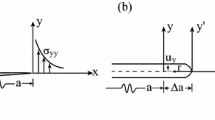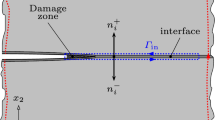Abstract
Many important interface crack problems are inherently three-dimensional in nature, e.g., debonding of laminated structures at corners and holes. In an effort to accurately analyze three-dimensional interface fracture problems, an efficient computational technique was developed that utilizes enriched crack tip elements containing the correct interface crack tip asymptotic behavior. In the enriched element formulation, the stress intensity factors K I, K II, and K III are treated as additional degrees of freedom and are obtained directly during the finite element solution phase. In this study, the results that should be of greatest interest are obtained for semi-circular surface and quarter-circular corner cracks. Solutions are generated for uniform remote tension and uniform thermal loading, over a wide range of bimaterial combinations. Of particular interest are the free surface effects, and the influence of Dundurs’ material parameters on the strain energy release rate magnitudes and corresponding phase angles.
Similar content being viewed by others
References
Atluri SN, Nishioka T (1986) Computational methods for three-dimensional problems of fracture. In: Atluri S (ed) Proceedings of the computational methods in the mechanics of fracture, vol 2 in computational methods in mechanics. Elsevier Science Publishers, Amsterdam, pp 229–287
Ayhan AO (1999) Finite element analysis of nonlinear deformation mechanisms in semiconductor packages. Ph.D. Dissertation, Lehigh University
Ayhan AO, Nied HF (1999) FRAC3D—finite element based software for 3-D and generalized plane strain fracture analysis (second revision). SRC Technical Report
Ayhan AO, Nied HF (2002) Stress intensity factors for three-dimensional surface cracks using enriched finite elements. Int J Numer Methods Eng 54(6):899–921
Babuska I, Melenk JM (1997) The partition of unity method. Int J Numer Methods Eng 40(4):727–758
Begley MR, Ambrico JM (2001) Delamination of thin films from two-dimensional interface flaws at corners and edges. Int J Fract 112:205–222
Chen EP (1985) Finite element analysis of a bimaterial interface crack. Theor Appl Fract Mech 3:257–262
Dundurs J (1969) Edge bonded dissimilar orthogonal elastic wedges. J Appl Mech 36:650–652
England AH (1965) A crack between dissimilar media. J Appl Mech 32:400–402
Erdogan F (1963) Stress distribution in a nonhomogeneous elastic plane with cracks. J Appl Mech 30:232–237
Erdogan F (1965) Stress distribution in bonded dissimilar materials with cracks. J Appl Mech 32:403–410
Ghahremani F, Shih CF (1992) Corner singularities of three-dimensional plane interface cracks. J Appl Mech 59:61–68
Gosz M, Dolbow J, Moran B (1998) Domain integral formulation for stress intensity factor computation along curved three-dimensional interface cracks. Int J Solids Struct 35(15):1763–1783
Herr AF, Nied HF (2005) Numerical simulation of 3-D mixed-mode crack propagation on bimaterial interfaces. In: Proceeding of ICF11, 11th international conference on fracture, Turin, Italy, CD-ROM, No. 5115, 20–25 March 2005
Hutchinson JW, Suo Z (1992) Mixed mode cracking in layered materials. In: Hutchinson JW, Wu TY (eds) Advances in applied mechanics, vol 29. Academic Press, NY, New York, pp 63–191
Kassir MK, Bregman AM (1972) The stress intensity factor for a penny-shaped crack between two dissimilar materials. J Appl Mech 39:308–310
Kaya AC, Nied HF (1993) Interface fracture analysis of bonded ceramic layers using enriched finite elements, ceramic coatings, MD-vol 44. In: Kokini K (ed) Proceedings of the 1993 ASME winter annual meeting. New Orleans, LA, pp 47–71
Lin KY, Mar JW (1976) Finite element analysis of stress intensity factors for cracks at a bi-material interface. Int J Fract 12:521–531
Malyshev BM, Salganik RL (1965) The strength of adhesive joints using the theory of fracture. Int J Fract Mech 1:114–128
Newman JC, Jr, Raju IS (1986) Stress-intensity factor equations for cracks in three-dimensional finite bodies subjected to tension and bending loads. In: Atluri S (ed) Proceedings of the computational methods in the mechanics of fracture, vol 2 in computational methods in mechanics. Elsevier Science Publishers, Amsterdam, pp 311–334
Nied HF (2003) Mechanics of interface fracture with applications in electronic packaging. IEEE Trans Device Mater Reliab 3(4):129–143
Nied HF, Kaya AC (1992) FRAC2D—finite element based software for 2-D and axisymmetric fracture analysis. Class 1 General Electric Technical Report
Ortiz JE, Cisilino AP (2005) Boundary element method for J-integral and stress intensity factor computations in three-dimensional interface cracks. Inter J Fract 133:197–222
Rice JR (1988) Elastic fracture mechanics concepts for interfacial cracks. J Appl Mech 55:98–103
Rice JR, Sih GC (1965) Plane problems of cracks in dissimilar media. J Appl Mech 32:418–423
Rossmanith H-P (1997) Damage and failure of interfaces. In: Rossmanith H-P (ed) Proceedings of the first international conference on damage and failure of interfaces – DFI-1, Vienna, Austria, 22–24 September 1997, A. A. Balkema Publishers, Rotterdam, The Netherlands
Strouboulis T, Copps K, Babuska I (2001) The generalized finite element method. Comput Methods Appl Mech Eng 190(32–33):4081–4193
Sukumar N, Huang ZY, Prévost J-H, Suo Z (2004) Partition of unity enrichment for bimaterial interface cracks. Int J Numer Methods Eng 59:1075–1102
Sukumar N, Moes N, Moran B, Belytschko T (2000) Extended finite element method for three-dimensional crack modelling. Int J Numer Methods Eng 48:1549–1570
Williams ML (1959) The stresses around a fault or crack in dissimilar media. Bull Seismol Soc Am 49:199–204
Xu A (2002) Finite element analysis of three-dimensional corner stress singularities and its application in microelectronics packaging. Ph.D. Dissertation, Lehigh University
Author information
Authors and Affiliations
Corresponding author
Rights and permissions
About this article
Cite this article
Ayhan, A.O., Kaya, A.C. & Nied, H.F. Analysis of three-dimensional interface cracks using enriched finite elements. Int J Fract 142, 255–276 (2006). https://doi.org/10.1007/s10704-006-9040-7
Received:
Accepted:
Published:
Issue Date:
DOI: https://doi.org/10.1007/s10704-006-9040-7




